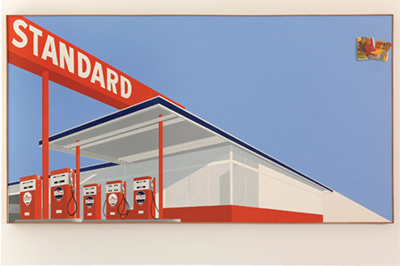 How do these travel images differ from Ruscha’s other work?
How do these travel images differ from Ruscha’s other work? Well, the deadpan attitude is the same. It’s all about vernacular imagery. It’s about looking at things that you usually edit out or don’t notice, looking at them carefully and without bias. When that is done, you notice how funny things really are. The difference here is that the vernacular is on the side of the road: gas stations, billboards, mileage signs, apartment buildings, distant horizons… What I wanted to do was create a mood, along with a visual journal of fragments you might see from behind the wheel of a moving car. Sometimes the language in Ed’s paintings relates to signs, and sometimes to thoughts you might have while driving. This is a very rich vein within Ed’s work.
There are so many famous pieces included in the exhibit. Which are the real standouts for you?
His two largest and most powerful Standard Station paintings are here. They’re really dynamic — depicting huge, sweeping overhead canopies jutting out toward the viewer, as if you were approaching this ultra-modern fuel depot from the road at 65 miles an hour. Twentysix Gasoline Stations is a classic, pioneering example of an Artist’s Book. There’s no story, no plot, just deadpan images of gas stations along Route 66 taken in harsh light. Ed was one of the first to point out the strange, pseudo-modernist architecture of the American gas station. He saw them like small western towns with one or two employees on desolate stretches of western roads.





 Facebook
Facebook Permalink
Permalink Digg
Digg Reddit
Reddit LinkedIn
LinkedIn StumbleUpon
StumbleUpon Tumblr
Tumblr

